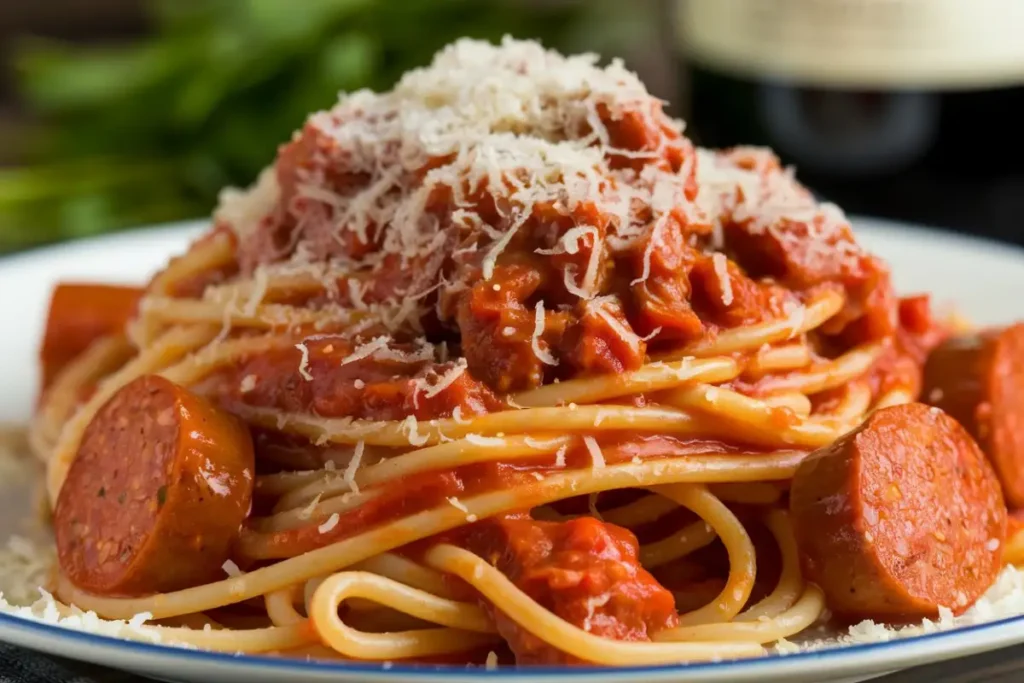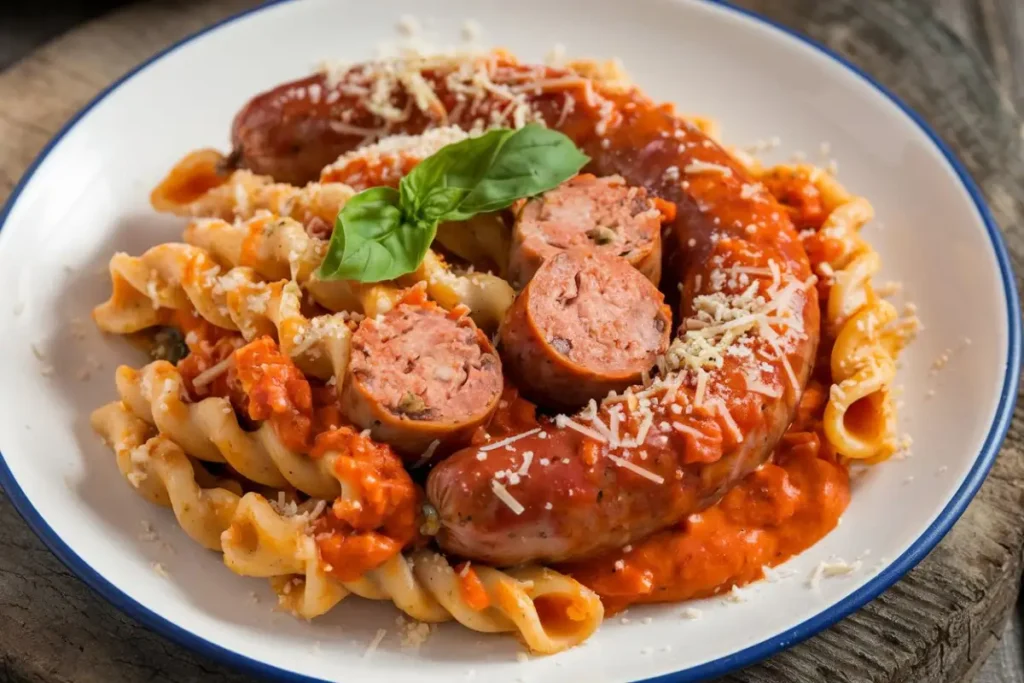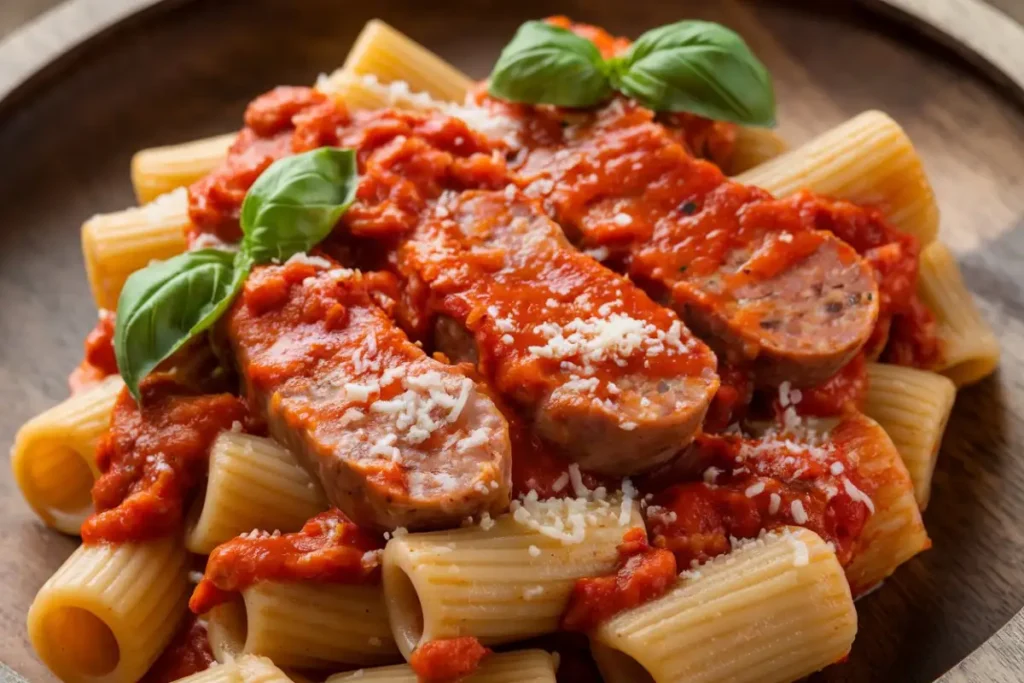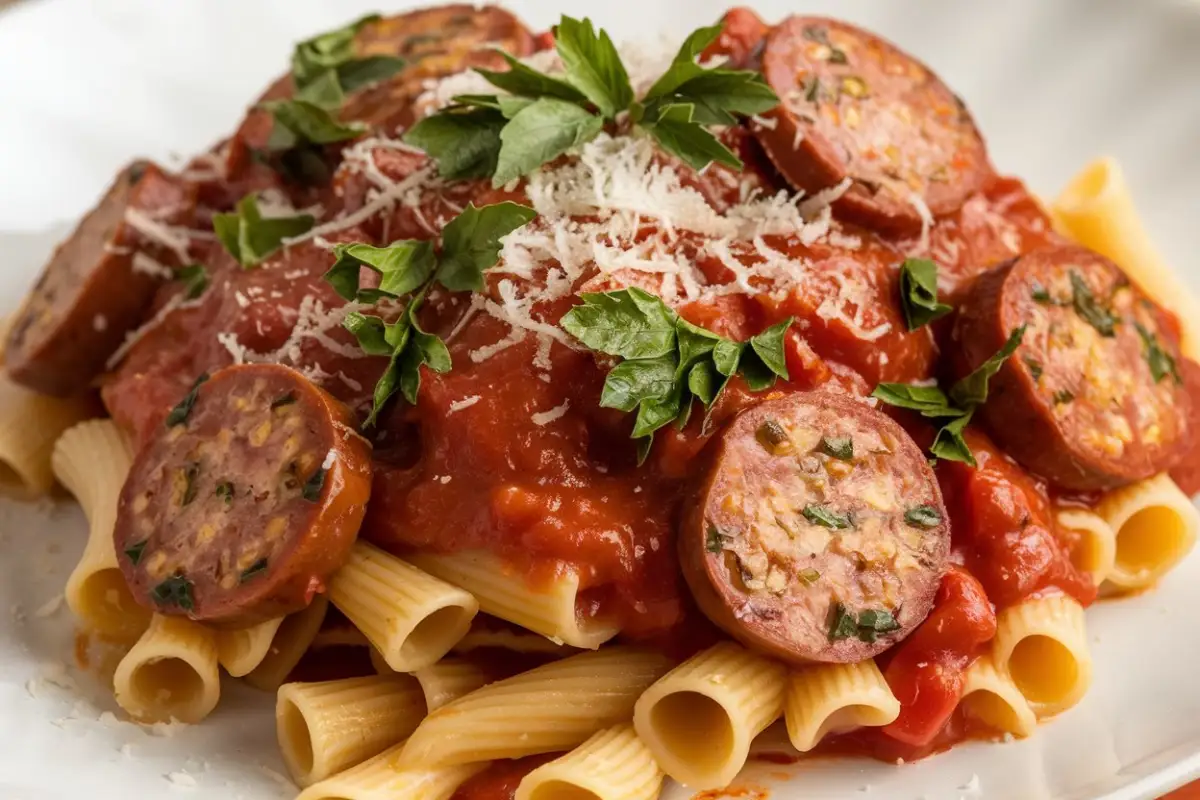Let’s be honest, is there anything more soul-satisfying than a big bowl of Italian Sausage Pasta? I think not! It’s that quintessential comfort food that just works, no matter the occasion. Whether you’re feeding a hungry family after a long day, hosting a casual get-together with friends, or just craving a warm, flavorful meal for yourself, this dish always delivers. It’s a hug in a bowl, really!
A Culinary Classic with Endless Variations
What I love most about Italian Sausage Pasta is its versatility. It’s not a rigid, stuffy recipe that demands perfection. Instead, it’s a beautiful canvas for your culinary creativity. You can tweak the ingredients, adjust the spice level, and play with different pasta shapes to create a dish that’s uniquely you. Seriously, once you master the basic technique, the possibilities are endless. We’re talking pasta paradise!
Beyond Red Sauce: Exploring Flavor Profiles
Sure, a classic marinara is a fantastic base, but don’t be afraid to venture beyond the red sauce. Think creamy tomato sauces, spicy arrabbiata, or even pesto-based creations. The beauty of Italian Sausage Pasta lies in its adaptability to different flavor profiles. This isn’t just about throwing ingredients together; it’s about crafting a symphony of tastes that will tantalize your taste buds. Are you ready to become the conductor of your own pasta orchestra?
Understanding the Key Ingredients for the Perfect Pasta
Okay, let’s dive into the building blocks of this masterpiece. To make truly amazing Italian Sausage Pasta, you need to understand the role each ingredient plays. It’s not just about following a recipe; it’s about understanding why you’re using certain components and how they interact with each other.
Choosing the Right Italian Sausage: Sweet, Hot, or Mild?

This is where the magic begins! The type of Italian sausage you choose will dramatically impact the overall flavor of your dish.
- Sweet Italian Sausage: Offers a subtle, savory flavor with hints of fennel and anise. It’s a great option for those who prefer a milder taste. Think of it as the gentle, approachable friend of the sausage family.
- Hot Italian Sausage: Packed with red pepper flakes and other spices, this sausage delivers a fiery kick that will wake up your palate. It’s the adventurous, thrill-seeking member of the group. If you like things spicy, this is your go-to.
- Mild Italian Sausage: A good middle ground. It has a savory flavor, but without the prominent sweetness or heat. It’s a safe bet if you’re unsure what everyone prefers.
Consider your audience and your own personal preference when making this crucial decision. There’s no right or wrong answer, just what tastes best to you.
Pasta Perfection: Selecting the Best Shape and Type

Pasta is more than just a vehicle for the sauce; it’s an integral part of the overall experience. Different shapes and textures will complement the sauce in different ways.
- Penne: The classic choice! Its ridged surface is perfect for catching sauce, and its hollow shape allows it to hold onto the sausage and vegetables.
- Rigatoni: Similar to penne, but larger and more robust. It can stand up to a heartier sauce and chunky ingredients.
- Farfalle (Bow Tie Pasta): Adds a touch of elegance to the dish. Its playful shape is visually appealing, and its texture provides a pleasant contrast to the sauce.
- Spaghetti: A timeless choice, although it can be a bit trickier to eat with sausage and vegetables.
- Orecchiette (Little Ears): Captures the sauce beautifully. The small, concave shape holds pools of deliciousness.
Ultimately, the best pasta shape is the one you enjoy the most. Don’t be afraid to experiment and find your favorite combination!
The Importance of High-Quality Tomatoes: Fresh vs. Canned
Tomatoes are the heart and soul of most Italian Sausage Pasta sauces. Using high-quality tomatoes will make a world of difference in the final product.
- Fresh Tomatoes: If you have access to ripe, juicy tomatoes, especially during the summer months, definitely use them! Roasting them beforehand can intensify their flavor.
- Canned Tomatoes: A convenient and reliable option, especially when fresh tomatoes are out of season. Look for San Marzano tomatoes, which are known for their sweetness and low acidity. Diced tomatoes, crushed tomatoes, or tomato puree all work well, depending on the texture you prefer.
Regardless of whether you opt for fresh or canned, make sure to choose tomatoes that are vibrant in color and have a rich, tomatoey aroma.
Garlic, Onions, and Herbs: Building a Flavorful Base
Don’t underestimate the power of aromatics! Garlic and onions are essential for building a complex and flavorful base for your sauce. Sauté them in olive oil until softened and fragrant before adding the other ingredients.
Fresh herbs, such as basil, oregano, and parsley, add a bright and aromatic touch. Add them towards the end of cooking to preserve their flavor. Dried herbs can also be used, but use them sparingly as they tend to have a more concentrated flavor. A bay leaf simmered in the sauce adds depth and complexity. Remember to remove it before serving!
“The secret to great Italian cooking is simplicity. Use quality ingredients, don’t overcomplicate things, and let the flavors speak for themselves.” Lidia Bastianich
The Essential Steps to Mastering Italian Sausage Pasta

Now that we’ve covered the key ingredients, let’s get down to the nitty-gritty of actually making this delicious dish. Don’t worry; it’s not as complicated as it might seem! These are the fundamental steps that will guide you to Italian Sausage Pasta perfection.
Browning the Sausage: Achieving Deep, Savory Flavors
This is arguably the most crucial step in the entire process. Don’t skip it! Browning the sausage not only cooks it through but also develops those deep, rich, savory flavors that make Italian Sausage Pasta so irresistible.
- Remove the Sausage from its Casing (Optional): You can either leave the sausage in its casing and slice it into rounds, or remove the casing and crumble the sausage. Crumbling often allows for better browning and distribution throughout the sauce.
- Heat Olive Oil in a Large Pan or Dutch Oven: Use a generous amount of olive oil to ensure the sausage doesn’t stick and browns evenly.
- Brown the Sausage Over Medium-High Heat: Cook the sausage, breaking it up with a spoon, until it’s browned on all sides and cooked through. This typically takes about 8-10 minutes.
- Drain Excess Grease: Nobody wants a greasy pasta sauce! Carefully drain off any excess grease from the pan, leaving behind just enough to sauté the aromatics.
Creating the Sauce: A Step-by-Step Guide
This is where you can really unleash your creativity! Here are a few sauce options to get you started:
Option 1: Classic Marinara
This is the quintessential Italian pasta sauce. Simple, flavorful, and always a crowd-pleaser.
- Sauté Aromatics: Add diced onions and minced garlic to the pan and sauté until softened and fragrant, about 5 minutes.
- Add Tomatoes: Stir in crushed tomatoes, tomato puree, or diced tomatoes.
- Season: Season with salt, pepper, dried oregano, dried basil, and a pinch of red pepper flakes (if desired).
- Simmer: Bring the sauce to a simmer, reduce the heat, and cook for at least 30 minutes, or up to an hour, to allow the flavors to meld.
Option 2: Creamy Tomato Sauce
A touch of cream adds richness and decadence to the classic marinara.
- Follow steps 1-3 for Classic Marinara.
- Stir in Cream: After simmering the sauce, stir in a splash of heavy cream or half-and-half. You can also use mascarpone cheese for an even richer flavor.
- Simmer Briefly: Simmer for another 5 minutes to allow the cream to thicken the sauce.
Option 3: Spicy Arrabbiata
For those who like a little heat!
- Sauté Aromatics: Add diced onions and minced garlic to the pan and sauté until softened and fragrant, about 5 minutes. Add a generous amount of red pepper flakes to the pan while sautéing the aromatics.
- Add Tomatoes: Stir in crushed tomatoes or diced tomatoes.
- Season: Season with salt, pepper, and dried oregano.
- Simmer: Bring the sauce to a simmer, reduce the heat, and cook for at least 30 minutes, or up to an hour, to allow the flavors to meld.
Cooking the Pasta: Al Dente is Key!
“Al dente” is Italian for “to the tooth,” which means the pasta should be firm and slightly resistant when you bite into it. Overcooked, mushy pasta is a culinary crime!
- Bring a Large Pot of Water to a Rolling Boil: Use plenty of water to prevent the pasta from sticking together.
- Add Salt: Generously salt the water. This seasons the pasta from the inside out.
- Add Pasta: Add the pasta to the boiling water and cook according to the package directions, subtracting 1-2 minutes for al dente.
- Reserve Pasta Water: Before draining the pasta, reserve about 1 cup of the starchy pasta water. This liquid gold will help emulsify the sauce and create a creamy, cohesive dish.
Combining Pasta and Sauce: The Art of Emulsification
This is the final step in creating pasta perfection. The goal is to create a harmonious marriage between the pasta and the sauce, so they become one cohesive unit.
- Add Pasta to Sauce: Drain the pasta and immediately add it to the pan with the sauce.
- Toss to Combine: Toss the pasta and sauce together until the pasta is evenly coated.
- Add Pasta Water (If Needed): If the sauce is too thick, add a splash of the reserved pasta water to loosen it up and create a creamy emulsion.
- Garnish and Serve: Garnish with fresh herbs, grated Parmesan cheese, and a drizzle of olive oil. Serve immediately and enjoy!
Common Problems & Solutions When Making Italian Sausage Pasta
Okay, let’s be real: even the most experienced cooks encounter hiccups in the kitchen. Italian Sausage Pasta is generally a forgiving dish, but there are a few common pitfalls to watch out for. Here’s a guide to troubleshooting those pesky problems:
Problem 1: Bland Sauce
A bland sauce is a major disappointment. Nobody wants pasta that tastes like… well, nothing. Thankfully, there are plenty of ways to amp up the flavor.
Solution: Boost Flavor with Umami-Rich Ingredients
Umami is that savory, “meaty” flavor that adds depth and complexity to dishes. Incorporating umami-rich ingredients can instantly transform a bland sauce into something truly special.
- Tomato Paste: A concentrated source of tomato flavor. Add a tablespoon or two to the sauce while it’s simmering.
- Sun-Dried Tomatoes: Provide a sweet and tangy flavor boost. Chop them finely and add them to the sauce.
- Anchovies: Don’t be scared! Anchovies dissolve into the sauce and add a subtle, savory depth. Use anchovy paste or finely chopped anchovy fillets.
- Mushrooms: Earthy and savory, mushrooms add a wonderful umami flavor. Sauté them with the onions and garlic before adding the tomatoes.
Solution: Taste and Adjust Seasoning Regularly
This is the golden rule of cooking! Taste your sauce frequently and adjust the seasoning as needed. Salt is essential for bringing out the flavors of the other ingredients. Add a pinch at a time and taste until the sauce is properly seasoned. Don’t forget to consider other seasonings like black pepper, red pepper flakes, dried herbs, and fresh herbs.
Problem 2: Overcooked or Mushy Pasta
Nobody likes mushy pasta. It’s unpleasant to eat and ruins the texture of the dish.
Solution: Cook Pasta Al Dente and Test Frequently
As mentioned earlier, al dente pasta is key! Start checking the pasta for doneness a few minutes before the package directions indicate. Use a fork to pull out a strand of pasta and taste it. It should be firm to the bite with a slightly chewy texture.
Solution: Avoid Overcrowding the Pot
Overcrowding the pot can lower the water temperature and cause the pasta to cook unevenly. Use a large pot and plenty of water to allow the pasta to cook properly.
Problem 3: Greasy Sauce
A greasy sauce can be unappetizing and heavy.
Solution: Drain Excess Grease from the Sausage
As mentioned earlier, make sure to drain off any excess grease from the sausage after browning it.
Solution: Use Leaner Sausage or Ground Turkey
If you’re particularly concerned about grease, opt for a leaner Italian sausage variety or substitute ground turkey for the sausage altogether.
Problem 4: Sauce is Too Acidic
Tomato sauce can sometimes be too acidic, especially if you’re using canned tomatoes. This can create a harsh, unpleasant flavor.
Solution: Add a Pinch of Sugar or Baking Soda
A pinch of sugar can help to balance the acidity of the tomatoes. Start with a small amount (about 1/4 teaspoon) and taste. You can also try adding a pinch of baking soda, which will neutralize the acid. Be careful not to add too much baking soda, as it can create a soapy taste.
Solution: Incorporate a Dairy Product (Cream, Ricotta)
Dairy products, such as cream, ricotta cheese, or mascarpone cheese, can help to neutralize the acidity of the tomatoes and add richness to the sauce.
Problem 5: Sausage is Dry and Crumbly
Dry, crumbly sausage is not only unappetizing but also doesn’t distribute its flavor as well throughout the sauce.
Solution: Don’t Overcook the Sausage
Overcooking the sausage will cause it to dry out. Cook it until it’s browned on all sides and cooked through, but don’t let it become too dry and brittle.
Solution: Add a Splash of Cooking Water to the Pan
If the sausage is starting to dry out, add a splash of the reserved pasta water to the pan. This will help to keep it moist and prevent it from becoming crumbly.
Elevate Your Italian Sausage Pasta: Creative Variations & Add-Ins
Ready to take your Italian Sausage Pasta to the next level? Let’s explore some exciting variations and add-ins that will transform this classic dish into something truly special. Think of this as your playground experiment, have fun, and create your own signature pasta!
Vegetable Power: Adding Nutritional Boosts
Incorporating vegetables into your pasta is a fantastic way to add nutrients, fiber, and flavor.
Bell Peppers and Onions: A Classic Combination
Sautéed bell peppers and onions are a classic addition to Italian Sausage Pasta. They add sweetness, color, and a satisfying crunch. Red, yellow, and orange bell peppers work particularly well.
Spinach or Kale: For a Healthy Twist
Adding spinach or kale is a great way to sneak in some extra greens. Simply wilt the spinach or kale in the sauce towards the end of cooking. Remember that kale will need a little longer to soften than spinach.
Mushrooms: Earthy and Savory Depth
As mentioned before, mushrooms add a wonderful umami flavor to the sauce. Cremini, shiitake, or portobello mushrooms are all excellent choices. Sauté them with the onions and garlic before adding the tomatoes.
Cheese, Please! Experimenting with Different Varieties
Cheese and pasta are a match made in heaven. Here are a few cheese options to consider:
Parmesan: The Traditional Topping
Parmesan cheese is the classic topping for Italian Sausage Pasta. Its salty, nutty flavor complements the sauce perfectly. Use freshly grated Parmesan cheese for the best flavor.
Ricotta: Creamy and Luxurious
Adding dollops of ricotta cheese to the pasta adds a creamy, luxurious element. Use whole milk ricotta cheese for the best flavor and texture.
Mozzarella: Melty and Delicious
Shredded mozzarella cheese melts beautifully into the pasta, creating a gooey, cheesy delight. Use low-moisture mozzarella cheese for the best results.
Spice It Up: Adding a Kick to Your Pasta
If you like things spicy, there are plenty of ways to add a kick to your Italian Sausage Pasta.
Red Pepper Flakes: A Simple Solution
Adding a pinch of red pepper flakes to the sauce is the easiest way to add a little heat.
Calabrian Chili Paste: For Intense Heat
Calabrian chili paste is made from spicy Calabrian chili peppers. It adds an intense, fruity heat to the sauce. Use it sparingly, as it’s quite potent.
Fresh Chili Peppers: Control the Spice Level
Finely chopped fresh chili peppers, such as jalapeños or serranos, allow you to control the spice level of the sauce. Add them to the pan while sautéing the onions and garlic.
Wine Pairing: Complementing Your Italian Sausage Pasta Dish
The right wine can elevate your Italian Sausage Pasta experience to new heights. Here are a few suggestions:
Red Wine Recommendations
Chianti Classico: A Classic Pairing
Chianti Classico, with its bright acidity and cherry fruit flavors, is a classic pairing for Italian Sausage Pasta with a tomato-based sauce.
Barbera: Fruity and Versatile
Barbera, with its juicy fruit flavors and low tannins, is a versatile wine that pairs well with a variety of pasta dishes.
White Wine Recommendations
Pinot Grigio: Light and Refreshing
Pinot Grigio, with its light body and crisp acidity, is a refreshing choice for Italian Sausage Pasta with a lighter sauce or vegetable-based add-ins.
Chardonnay (Unoaked): Adds Complexity without Overpowering
An unoaked Chardonnay can offer a nice balance, providing complexity without overwhelming the flavors of the dish.
Serving Suggestions & Presentation Tips
Presentation is key! Make your Italian Sausage Pasta look as good as it tastes.
Garnish Ideas: Fresh Herbs, Parmesan, and More
Fresh herbs, such as basil, oregano, and parsley, add a pop of color and aroma. Grated Parmesan cheese adds a salty, nutty flavor. A drizzle of olive oil adds richness and shine.
Side Dish Suggestions: Salad, Bread, and Vegetables
A simple green salad with a light vinaigrette is a refreshing accompaniment to Italian Sausage Pasta. Crusty bread is perfect for soaking up the delicious sauce. Roasted vegetables, such as broccoli or asparagus, add nutrients and fiber.
Plating Techniques: Making Your Pasta Look as Good as It Tastes
Use a large serving bowl or individual plates. Arrange the pasta artfully, and garnish generously. A sprig of fresh herbs adds a touch of elegance.
Recipe: Classic Italian Sausage Pasta (Step-by-Step)
Alright, time to put everything we’ve discussed into action! Here’s a classic Italian Sausage Pasta recipe that you can easily adapt to your own taste.
Ingredients List (Detailed and Precise)
- 1 pound Italian sausage (sweet, hot, or mild), casings removed
- 1 tablespoon olive oil
- 1 medium onion, diced
- 2 cloves garlic, minced
- 1 (28 ounce) can crushed tomatoes
- 1 (15 ounce) can tomato sauce
- 1 teaspoon dried oregano
- 1/2 teaspoon dried basil
- 1/4 teaspoon red pepper flakes (optional)
- Salt and pepper to taste
- 1 pound pasta (penne, rigatoni, or your favorite shape)
- 1 cup reserved pasta water
- Fresh basil leaves, for garnish
- Grated Parmesan cheese, for serving
Instructions (Clear and Concise)
- Brown the Sausage: In a large skillet or Dutch oven, brown the Italian sausage over medium-high heat, breaking it up with a spoon. Drain off any excess grease.
- Sauté Aromatics: Add the olive oil, diced onion, and minced garlic to the skillet. Sauté until the onion is softened and translucent, about 5 minutes.
- Add Tomatoes and Seasonings: Stir in the crushed tomatoes, tomato sauce, dried oregano, dried basil, and red pepper flakes (if using). Season with salt and pepper to taste.
- Simmer the Sauce: Bring the sauce to a simmer, reduce the heat to low, and cook for at least 30 minutes, or up to an hour, stirring occasionally.
- Cook the Pasta: While the sauce is simmering, cook the pasta according to package directions, until al dente. Reserve 1 cup of pasta water before draining.
- Combine Pasta and Sauce: Drain the pasta and add it to the skillet with the sauce. Toss to combine. If the sauce is too thick, add a splash of the reserved pasta water to loosen it up.
- Serve: Garnish with fresh basil leaves and grated Parmesan cheese. Serve immediately.
For more recipes Follow me in Facebook and Pinterest
Conclusion: Italian Sausage Pasta A Timeless Recipe for Every Cook
The Enduring Appeal of This Comforting Dish
Italian Sausage Pasta is more than just a meal; it’s an experience. It’s the aroma of garlic and herbs filling your kitchen, the sound of the sauce gently simmering on the stove, and the feeling of warmth and satisfaction after the last bite. Its enduring appeal lies in its simplicity, versatility, and ability to bring people together.
Call to Action: Share Your Creations and Favorite Variations!
I hope this guide has inspired you to create your own Italian Sausage Pasta masterpiece! I’d love to hear about your favorite variations and add-ins. Share your creations on social media using [Your Hashtag Here]!
Encouragement to experiment and adapt to your own taste.
Don’t be afraid to experiment! The best Italian Sausage Pasta is the one that you love the most. Adjust the recipe to suit your own taste preferences and dietary needs.
Frequently Asked Questions (FAQs) About Italian Sausage Pasta
Can I use frozen sausage?
Yes, you can use frozen sausage. Just make sure to thaw it completely before cooking.
How long does Italian Sausage Pasta last in the fridge?
Italian Sausage Pasta will last for 3-4 days in the fridge. Store it in an airtight container.
Can I freeze Italian Sausage Pasta?
Yes, you can freeze Italian Sausage Pasta. Freeze it in an airtight container for up to 2-3 months.
What’s the best way to reheat Italian Sausage Pasta?
Reheat Italian Sausage Pasta in the microwave, on the stovetop, or in the oven. Add a splash of water or broth to prevent it from drying out.
Is Italian Sausage Pasta Gluten-Free?
No, traditional Italian Sausage Pasta is not gluten-free, as it contains pasta made from wheat flour. However, you can easily make it gluten-free by using gluten-free pasta.
Can I make Italian Sausage Pasta vegetarian/vegan?
Yes, you can make Italian Sausage Pasta vegetarian or vegan by substituting the sausage with plant-based sausage alternatives.
Final Thoughts and Recap
Summary of key takeaways
Italian Sausage Pasta is a versatile and delicious dish that can be easily customized to your own taste. Choosing high-quality ingredients, browning the sausage properly, and cooking the pasta al dente are key to success.

